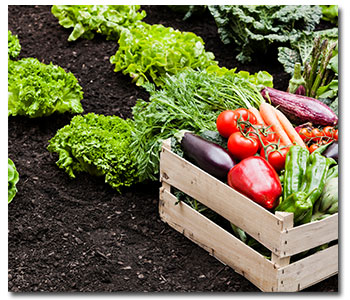Companion Planting

Cool Season Veggies
We have all had experience of meeting someone we instantaneously take a liking (or disliking) to. Most of us have encountered people who have helped us advance on our life’s journey in a positive way. On the flip side, some of us have been involved in what could only be described as a “toxic” relationship.
Turns out, the same interactions take place in the plant world (who knew?). By learning about these relationships (positive and negative), we are able to make the most of our gardening experiences in terms of increasing productivity and plant vigor and reducing the amount of time needed to maintain the garden.
The practice of planting certain varieties together that will provide a benefit or benefits to each other is called “Companion Planting” and has been practiced my Native Americans for as long as they have farmed the land. The most famous example of this is called the “Three Sisters”, which emerged from an Iroquois creation myth. In companion planting, “Three Sisters” means planting corn, beans and squash in close proximity to each other. These plants have a symbiotic relationship in that the corn provides a structure for the beans to climb, the beans (which are one of the few plants that are able to receive nitrogen from the air) provide the soil with nutrients, and the large leaves of the squash shade the soil and helps to conserve water and control the germination of weeds.
Companion planting can help your plants thrive in many ways including insect and weed control, space optimization and providing nutrients to the soil. It fits perfectly with organic gardening practices because, if done correctly it can reduce or eliminate the need for pesticides and herbicides.
Listed below are plants for the cool season garden that provide benefits to each other by being grown together:
See Richard Wrights Guide on companion planting
- Broccoli grows much more vigorously when planted with Dill or Mint (just be careful of the Mint – it tends to take over!)
- Cabbage is much less likely to get cabbage worms if planted with Rosemary, Sage, Chamomile, Thyme, Lavender, Celery, Dill, or Onions. The aroma of these plants repels the pests.
- Peas help almost any plant – they add nitrogen to the soil, which all plants need.
- Borage improves the soil nutrition for Strawberries.
- Rosemary grows well with Sage and improves the growth of Carrots and Cabbage.
- Plant Chives or Garlic near Roses to protect them from black spot and aphids. Parsley protects Roses from beetles.
- Planting Garlic around Peach Trees reduces the likelihood of Peach Leaf Curl occurring. It also repels borers when planted near susceptible varieties of fruit trees.
- Radishes, when planted with Lettuce will taste better.
- Potatoes will be more disease resistant if planted with Horseradish.
- Oregano planted with Broccoli, Cabbage and Cauliflower will repel cabbage butterfly.
- Leeks grow better if planted with Carrots, Celery or Onions.
And now for the “Hate”…here is a list of things that should NOT be planted together (in most cases, the vigor of one or both plants will be compromised when planted in close proximity):
- Dill and Carrots
- Onion and Peas
- Mint and Parsley
- Chard and Potatoes
- Fennel and almost everything (plant near a dog run – it repels fleas)
Try the planting combinations listed above and be rewarded with a more carefree garden this year – it really works!











